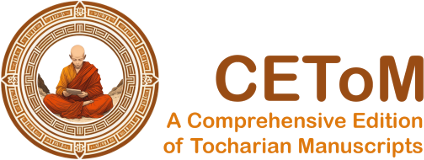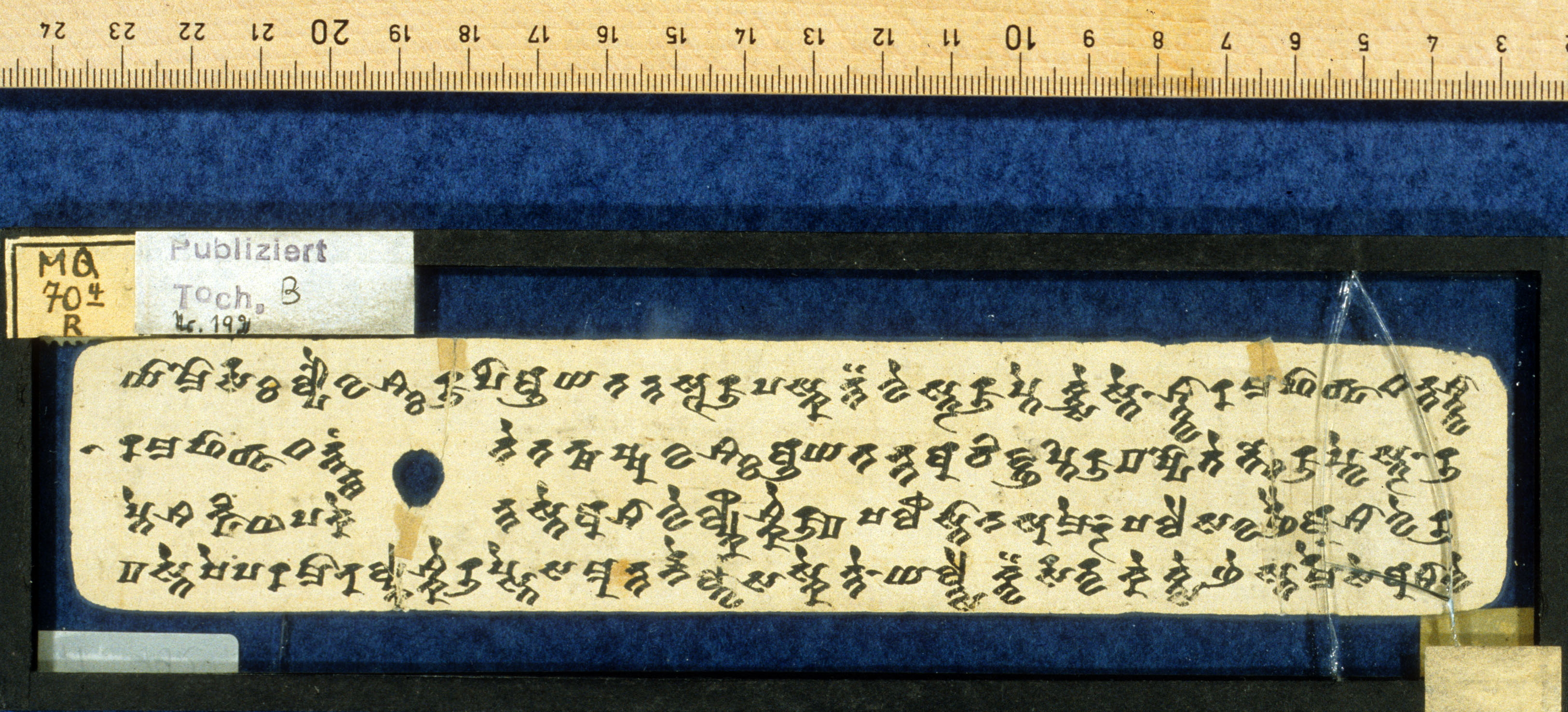THT 192
| Known as: | THT 192; B 192; Bleistiftnummer 2527 |
|---|---|
| Cite this page as: | "THT 192". In A Comprehensive Edition of Tocharian Manuscripts (CEToM). Created and maintained by Melanie Malzahn, Martin Braun, Hannes A. Fellner, and Bernhard Koller. https://cetom.univie.ac.at/?m-tht192 (accessed 08 Jul. 2025). |
Provenience | |
| Main find spot: | Kizil Ming-öy |
| Expedition code: | T III MQ 70.4 |
| Collection: | Berlin Turfan Collection |
Language and Script | |
| Language: | TB |
| Linguistic stage: | classical |
| Script: | classical |
Text contents | |
| Title of the work: | Abhidharmakośa |
| Text genre: | Literary |
| Text subgenre: | Abhidharma |
| Verse/Prose: | prose |
Object | |
| Material: | ink on paper |
| Form: | Poṭhī |
| Number of lines: | 4 |
Images
Images from idp.bbaw.de by courtesy of the International Dunhuang Project Berlin, the Berlin-Brandenburgische Akademie der Wissenschaften, and the Staatsbibliothek zu Berlin – Orientabteilung.
Transliteration
| a1 | || o mpa lsko ññe ṣme ñca ntse śa ko¯ ¯kt dha tu nma ne śa kwi ā ya ta nta ne pī śā ntseṃ ne śtwā ra smṛ tyu pa sthāṃ nta |
|---|---|
| a2 | ne ka rsa tsi skai nā lle kuse śa ko¯ ¯kt dha tu nma ske nte to na¯ ¯k śa¯ ¯k rū pī ā ya da nta ske nte |
| a3 | ṣu¯ ¯kt pa lsko nta au ltsu wa sū ṣe ma nā ya taṃ ñe¯ ¯m kuse dha rma dhā tu sū dha rmā ya taṃ ñe¯ ¯m toṃ ta kā re |
| a4 | śa ko kta meṃ śa kwi ā ya ta nä nta || ña ke śa kwi ā ya ta nta ye lpa llo na pī śā ntseṃ ne ya pa s̝s̝a llo na ku[c]e |
| lf | 1 |
| b1 | yā mo rsa ka lpau wa śa¯ ¯k rū pī ā ya ta nta sū rū pa ska ntä we stra rū pte kuse ste • śtwā ra ma hā bhū ta nta śtwā |
| b2 | ra ma hā bhū ta ntaṃ¯ ¯ts te ta nma ṣṣu wa śa¯ ¯k ā ya ta nta a vi jña pti rū pa ṣpo te to¯ ¯t rū pwe stra • ru |
| b3 | pte śa kpi¯ ¯ś pa ke nta ste a śā we lyki śke rū¯ ¯p ṣa li stā na su me¯ ¯r ṣa le sa wa rñai a śā we ru |
| b4 | pa ste ṣe pa ra mā nu lyka śke ru pste sa mu tta rne lwā sa ske nte • ya ltse kwä rsa rwa ke ktse ñe sta rme se a śā we |
Transcription
| lf | 1 |
| a1 | ॥ ompalskoññe ṣmeñcantse śak okt dhatunmane śak wi āyatantane pīś āntseṃne śtwāra smṛtyupasthāṃnta |
|---|---|
| a2 | -ne karsatsi skainālle kuse śak okt dhatunma skente tona-k śak rūpī āyadanta skente |
| a3 | ṣukt pälskonta aultsuwa sū ṣe manāyataṃ ñem kuse dharmadhātu sū dharmāyataṃ ñem toṃ takāre |
| a4 | śak oktameṃ śak wi āyatanänta ॥ ñake śak wi āyatanta yelpallona pīś āntseṃne yapäṣṣällona kuce |
| b1 | yāmorsa kälpauwa śak rūpī āyatanta sū rūpaskantä westrä rūp te kuse ste • śtwāra mahābhūtänta śtwā¬ |
| b2 | ra mahābhūtäntaṃts tetanmäṣṣuwa śak āyatanta avijñaptirūpä ṣ po te tot rūp westrä • ru¬ |
| b3 | p te śak piś pakenta ste aśāwe lykiśke rūp ṣali stāna sumer-ṣalesa warñai aśāwe ru¬ |
| b4 | p{†ä} ste ṣe paramānu lykaśke rup ste samuttarne lwāsa skente • yaltse kwärsarwa kektseñe star-me se aśāwe |
Translation
| a4+ | What/How about the ten Rūpāyatana's? (= as for the ten Rūpāyatana's), this is called a Rūpaskandha. |
|---|
Other
| b1+ | Die vier Mahābhūtas [großen Elemente], die von den vier Mahābhūtas hervorgerufenen zehn Āyatanas [Sinneswahrnehmungen] und das Avijñaptirūpa [Rūpa der Nichtbekanntgabe], all das wird Rūpa genannt. (Schmidt 1974: 225) |
|---|
References
Online access
Edition
Translations
Carling 2000: b4 (132); Couvreur 1954c: a1 a2 a3 a4 b1 b2 b3 b4 (112-113); Hackstein 2012: a4 b1 (132); TEB II: a3 (68), a3 a4 (68), a4 b1 (68), b3 (68); Schmidt 1974: b1 b2 (225); Thomas 1952: a1 (19); Thomas 1954: a1 a2 (726); Thomas 1967a: a3 (74); Thomas 1967c: b1 b2 (177); Thomas 1979b: a4 (39); Thomas 1988: a1 a2 (246); Thomas 1997: a1 a2 (99), b2 (71)
Bibliography
Carling, Gerd. 2000. Die Funktion der lokalen Kasus im Tocharischen. Berlin/New York: de Gruyter.
Couvreur, Walter. 1954c. “Koetsjische literaire fragmenten uit de Berlijnse verzameling (naar aanleiding van Sieg & Siegling’s Tocharische Sprachreste).” Handelingen VIII der Zuidnederlandse Maatschappij voor Taal- en Letterkunde en Geschiedenis, 97–117.
Hackstein, Olav. 2012. “The evolution of finite complementation in Tocharian.” Tocharian and Indo-European Studies 13: 117–48.
“The International Dunhuang Project: The Silk Road Online.” n.d. http://idp.bl.uk.
Schmidt, Klaus T. 1974. “Die Gebrauchsweisen des Mediums im Tocharischen.” PhD, Universität Göttingen.
Sieg, Emil, and Wilhelm Siegling. 1953. Tocharische Sprachreste. Sprache B, Heft 2. Fragmente Nr. 71-633. Edited by Werner Thomas. Göttingen: Vandenhoeck & Ruprecht.
Thomas, Werner, and Wolfgang Krause. 1964. Tocharisches Elementarbuch, Band II. Texte und Glossar. Heidelberg: Winter.
Thomas, Werner. 1952. Die tocharischen Verbaladjektive auf -l. Deutsche Akad. der Wissenschaften zu Berlin, Institut für Orientforschung 9. Berlin: Akademie-Verlag.
Thomas, Werner. 1954. “Die Infinitive im Tocharischen.” In Asiatica. Festschrift Friedrich Weller. Zum 65. Geburtstag, gewidmet von seinen Freunden, Kollegen und Schülern, edited by Johannes Schubert and Ulrich Schneider, 701–64. Leipzig: Harrassowitz.
Thomas, Werner. 1967a. “Zu den Ausdrücken mit A ñom, B ñem im Tocharischen.” Indogermanische Forschungen 72: 58–78.
Thomas, Werner. 1967c. “Zu wortverbindendem toch. A śkaṃ/ B ṣpä.” Zeitschrift für Vergleichende Sprachforschung 81: 161–80.
Thomas, Werner. 1979b. Formale Besonderheiten in metrischen Texten des Tocharischen: Zur Verteilung von B tane/tne “hier” und B ñake/ñke “jetzt”. Abhandlungen d. Geistes- und Sozialwissenschaftlichen Klasse 15. Mainz: Verlag d. Akad. d. Wissenschaften und d. Literatur.
Thomas, Werner. 1988. “Toch. AB säm-/läm- ‘sitzen’ in transitivem Gebrauch.” Central Asiatic Journal 32: 244–59.
Thomas, Werner. 1997. Interpretationsprobleme im Tocharischen. Unflektiertes A puk, B po “ganz, all, jeder”. Vol. 3. SbWGF, XXXV. Stuttgart: Steiner.
Gippert, Jost, Katharina Kupfer, Christiane Schaefer, and Tatsushi Tamai. n.d. “Thesaurus Indogermanischer Text- und Sprachmaterialien (TITUS): Tocharian Manuscripts from the Berlin Turfan Collection.” http://titus.fkidg1.uni-frankfurt.de/texte/tocharic/thtframe.htm.




